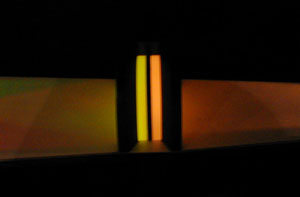Does everybody see the same colors that I see?

Digital camera view of Comparing Yellows,
the dot at 5 o'clock is the closest in color to the center
dot.
Does everybody see the same colors that I see?

Digital camera view of Comparing Yellows,
the dot at 5 o'clock is the closest in color to the center
dot.
With 10 or more people look at the exhibit Comparing Yellows.
To Do and Notice
What do you see?
Many groups report that they see a central dot of color which looks yellowish-tan surrounded by an arc of colored dots ranging from greenish at 7 o'clock to reddish at the 5 o'clock position.
I ask them which of the outer arc of colored dots most closely matches the central dot.
I point at the dots one at a time while people raise their hands. Some people see that different outer dots match the central dot in color. It is important to be honest.
What's Going On?
The central dot is composed of light with one wavelength*, it is seen as yellow.
The outer ring of dots is each made of a mixture of two different wavelengths of light, one which by itself is seen as greenish and another which is seen as reddish. However the amount of green and the amount of red is different for each different dot.
Most people see the dots near 3 o'clock as the ones that most closely match the central dot.
Some people give wildly different answers. (The exhibit builder designed the exhibit so that the dot at 12 o'clock most closely matched the central dot in his perception.).
Different people have different numbers of the different types of cone cells which detect colored light. Some with no cones which respond to one region of the spectrum are said to be colorblind. Others have four different cones and can discern variations between colors that look the same to the average viewer. However in different people, there can be small differences in the numbers of each type of cone and also in the chemicals which detect the light, these differences lead to different perceptions among viewers.
A question answered
Thus you can see that two people can look at the same light and
see different colors.
It's hard to believe that there can be such a simple answer to such a
difficult sounding question.
So What?
Some people are colorblind, they give wildly different answers to the question of which dots most closely match. Yet others who can pass the standard colorblindness tests also disagree about which dots match in color.
There seems to be a spectrum of colorblindness.
Going Further
Try observing this exhibit from a greater distance. Notice how your perception of which color matches depends on distance.
When you are done with this exhibit step over to the exhibit "Seeing Yellow" and conduct some more experiments. At seeing yellow you can adjust the red and green lights until they match the yellow light. Then ask a friend to do the same. You can also create your own experiments.

Scientific
Explorations with Paul
Doherty 18 September 2002